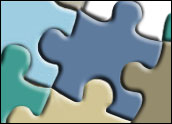
I have always been interested in the similarities between biology and economics and ultimately business. In the last few years we’ve adopted some of the parlance of biology when we talk about business, especially social business. Perhaps the best example is the analogy we freely make between a vendor and its partners and supply chain, i.e. “the ecosystem.” But itdoesn’t stop there; it extends to the customer as well.
We use “ecosystem” in a truncated form, assuming all relationships are good or beneficial, but that doesn’t have to be the case, and reality does not support this sanguine view. After all, there is a relationship between the gazelle and the lion, though it only seems to benefit one side. But even here, the lion provides a valuable service — if not to individual gazelles, at least to the species — by weeding out the least well-adapted and the plain unlucky.
Varieties of Relationships
If you study an ecosystem, there are at least four kinds of relationships, and one defines each species’ place in it. You can even represent these relationships in a two-by-two chart that describes these symbiotic relationships. Let’s take a quick look at them and then make the CRM point of this piece.
The four symbiotic relationships that define life in an ecosystem are:
- Mutualism, a relationship between two species of organisms in which both benefit from the association.
- Commensalism, a type of relationship between two species (plant, animal, fungus, etc.) in which one lives with, on, or in another without damage to either.
The next two are tricky because they seem rather similar.
- Amensalism is a symbiotic relationship in which one organism is harmed or inhibited and the other is unaffected.
- Parasitism is a relationship between organisms in which one lives as a parasite on another.
We well understand parasites, but the relationship does not have to be destructive. The big difference between the last two is that parasites may harm their hosts but the best parasites derive all their needs from the host without harm. There can be parasites that are amensalists, but that’s getting rather technical. How would you describe the relationship between the dairy farmer and his herd?
A Parasitic/Amensalic Approach
I sometimes think that one of the big tests of CRM and especially our socialized version is that much of business has evolved along the lines of the last two — parasitism and amensalism. If the last decade of CRM has taught us anything, it is that business needs to get to commensalism or mutualism. Customers are demanding it, and even our language about business suggests this.
Do we have customers or consumers? In my mind, customer describes a more mutualistic relationship, while consumer suggests a relationship that is at best parasitic, and maybe not in a neutral way. Our software necessarily reflects our take on the relationship. For instance, is our sales software designed to accelerate deals or to help us do good, mutually beneficial business?
You can’t let customers off the hook, either. How many of us seek only the best deal regardless of whether that deal leaves the vendor without sufficient margin to provide decent support? In these Occupy Wall Street Days, it might not be fashionable to feel for the vendor, but you can’t have a relationship with only one party, so the condition of the opposite member is always a concern. Note that our four definitions make that implicit point.
The March Toward Mutualism
Social technology is what enables mutualism; it is a necessary but far from sufficient condition of the relationship that social technologies exist. Interestingly, without it we are all independent actors interfacing with a sometimes impossibly large vendor. Without social we are all nothing more than consumers, and that’s the point of business today.
Economics may need to be reconsidered in light of social media. Think about it: One of the bedrock assumptions of economics is the rational actor theory. We’re all rational actors who make decisions and take actions based on our analysis of available information. So how is this affected when information is so much more available through social media? Does having more knowledge — including knowing that others know more or ought to — reduce our options in the market? I think it does, and it means relationships need to be more equal — commensalism or mutualism.
It’s my observation that companies that have yet to adopt social approaches and technologies have consumers. But as time goes on and those same people interact in different ways with each other and with other vendors, the differences between being a consumer and a customer become glaringly apparent.
Companies can adopt social technologies and techniques in an attempt to “speed up” conventional relationships. But the more successful companies already show that social moves the needle in the direction of mutualism.























































